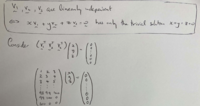Mampac
New member
- Joined
- Nov 20, 2019
- Messages
- 49
Hi there,
In R100 we are given three vectors:
v1 = (1, 2, 3, 4, . . . , 100),
v2 = (2, 3, 4, 5, . . . , 100, 0),
v3 = (3, 4, 5, 6, . . . , 100, 0, 0).
Have to show these are linearly independent, without any row-echelon matrix.
I know that the rows are dependent if [MATH]detA = 0[/MATH], so I've gotta prove the opposite.
I see only 2 ways of finding the determinant -- out of the ones we've covered so far:
1) I'm hesitating to use the Triangle method, since we have unknowns. Can I form a matrix, by rows, then get a21, a31, a32 nullified and say that the product of the diagonal is nonzero? I'm hesitating since it's not a square matrix in this case. Even here I get 1 * -1 * 0 = 0.
2) As about Laplace expansion... I just can't find a valid entry to use this theorem on, even when I perform row-operations. Everything fails. If I sequester 3 columns from the ones known and create a matrix I always get a zero determinant.
By the way, when creating a matrix, should I drop the last zeros in v2 and v3, or should I append more to v1 and v2?
It seems to me there's a mistake in the subject and it should've been "show whether independent", because to me these rows are dependent as ****.
In R100 we are given three vectors:
v1 = (1, 2, 3, 4, . . . , 100),
v2 = (2, 3, 4, 5, . . . , 100, 0),
v3 = (3, 4, 5, 6, . . . , 100, 0, 0).
Have to show these are linearly independent, without any row-echelon matrix.
I know that the rows are dependent if [MATH]detA = 0[/MATH], so I've gotta prove the opposite.
I see only 2 ways of finding the determinant -- out of the ones we've covered so far:
1) I'm hesitating to use the Triangle method, since we have unknowns. Can I form a matrix, by rows, then get a21, a31, a32 nullified and say that the product of the diagonal is nonzero? I'm hesitating since it's not a square matrix in this case. Even here I get 1 * -1 * 0 = 0.
2) As about Laplace expansion... I just can't find a valid entry to use this theorem on, even when I perform row-operations. Everything fails. If I sequester 3 columns from the ones known and create a matrix I always get a zero determinant.
By the way, when creating a matrix, should I drop the last zeros in v2 and v3, or should I append more to v1 and v2?
It seems to me there's a mistake in the subject and it should've been "show whether independent", because to me these rows are dependent as ****.

